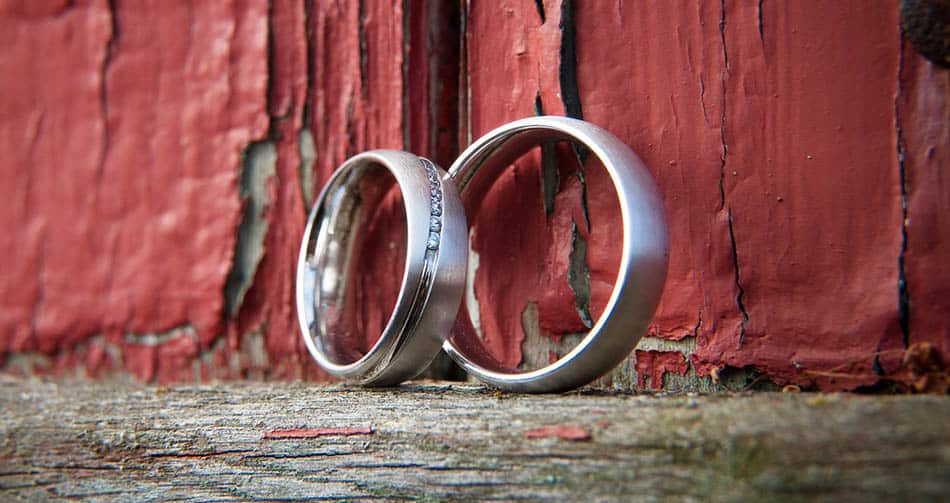
I thought stainless steel jewelry would never rust, then why would they rust and tarnish but some wouldn’t? If your jewelry has rusted, the method below will help refurbishing your jewelry back to nice and shine.
In the old days making stainless steel jewelry, the factory would often use 304 and 304L stainless steel quality series, which contain about 18-20% of chromium and 8-12% of nickels. These have great resistance to corrosion with good formability. In fact, there are tons of brand named watch companies use stainless steel for their watches. One main reason, because of the price when compared to precious metals. Another main point is stainless steel alloy are known for strong corrosion resistance and everlasting design.
But today we are seeing more stainless steel jewelry are switching to 430 grading series, the Ferritic type with low nickel content which contained less than 1% of nickel. These are also commonly used for smaller pieces such as earrings and tiny bead caps. And you will be surprised, some rings and bracelets thought to be genuine stainless steel may not even be stainless steel. This is the reason why your stainless steel jewelry developing some rust. You could be wearing a plated stainless steel jewelry or false marketing gimmicks jewelry.
One of the best way of cleaning stainless steel rust on jewelry is with white vinegar and you can do it at home. This method is safe, quick and easy. And by far it is the best suggested way, especially if you are cleaning small pieces or tight area such as earrings or those tiny loops and gaps.
You start by simply soak your stainless steel jewelry with white vinegar for about 3-10 minutes (depend how thick of the rust and delicate of the jewelry) After a few minutes of soaking, the rust may disappear but you might need some soft scrubbing to finish the job. Do keep in mind to use a soft cloth because stainless steel jewelry can easily get scratched. And finally, be sure to rinse and dry off your jewelry after each clean.
Although white vinegar might be one of the top choice but we really cannot rely on just using one method when cleaning your favorite jewelry. I will list five more different ways in which you may also consider of using to get rid of those rusts. Do bear in mind, always wear protective gears, never rub with abrasive solution, using exclusive stainless steel jewelry cleaner if available and most important keep bleach and strong acid cleaners far away from your jewelry to prevent unnecessary damage. But let’s first understand a little more about stainless steel so you can be confident next time you are buying your stainless steel jewelry or other kitchen appliance.
How Many Types of Stainless Steel Are There?
There are five different types or groups of stainless steel which also can be found in making stainless steel jewelry. They are known for the silvery shiny, attractive look and durability. Each type has its own pros and cons.
Five Main Groups of Stainless Steel
- Austenitic
- Ferritic
- Martensitic
- Duplex
- Precipitation Hardening Steel
These five groups of stainless steel holds a numbers of series and special alloy in defining their grading, mainly to divergence the percentage mixture of chromium, nickels, carbons and other alloy elements. For the last decade, more jewelry factories are using less chromium and nickels when making their stainless steel jewelry due to the competitive prices.
So which group of stainless steel should you choose when finding your stainless steel jewelry?
Austenitic is the largest portion of the global stainless steel market and have a wide range of application such as food processor equipment, kitchen utensils and medical equipment. Austenitic has great temperature resistance, non-magnetic and good weldable ability.
They usually divided into three groups. The 300s series which are commonly contain a good amount of chromium and nickel. The 200s series and the key elements contain manganese, chromium, nickel and nitrogen. The third group is the special alloys, which has a broad group of alloy materials. Therefore there is no standard mixture, it serve to delivery our society demand and request.
Ferritic has a noticeable amount of nickel with 12-17% of chromium and less than 0.1% of carbon, then the rest with other alloys element such as aluminium, titanium etc. They are magnetic but not heat treatable and often cost less than other stainless steel. The series number grading are 405, 409 and 430.
They do have a good ductility and form ability. But usually preform poorly with high temperature strength in comparing with austenitic grades. But they are quite similar to austenitic and also contain a good percentage of chromium.
Because of the high carbon, it is necessary preheat and post weld heat treatment to prevent any cracking. Which also affect the forming and welding. This material often can be commonly found through dental, surgical equipment and knives. The series grading numbers include 403, 410, 410NiMo, 420.
Duplex usually apply to piping and chemical plants. Because they have a higher yield strength and great stress corrosion cracking to chloride. One of the reason why they have a strong corrosion resistance is because they hold near 20-25% Chromium.
Precipitation Hardening has a unique mixture of alloys and allow steel to be hardened by aging or by solution. Beside chromium and nickel, they also contain other alloys such as aluminum, copper and titanium. Some seller will characterized them as austenitic or semi-austenitic or even martensitic.
Does Stainless Steel Jewelry Tarnish?
Stainless steel jewelry is rust and tarnish resistance. Because they contain a good portion of chromium. By default, there is an invisible outer layer which pushes the oxygen out, this is what preventing the metal from rusting or corroding. The uniqueness of a genuine stainless steel jewelry is not only the classic beauty shines. But also there long lasting durability.
| Magnetic Response *Steel attraction to magnet | High Temp. Resistance | Low Temp. Resistance *Sub-zero temp | Ductility | Hardening Work Rate | Corrosion Resistance | Tarnish | |
| AUSTENITIC | No (In most cases) | Very High | Very High | Very High | Very High | High | No |
| FERRITIC | Yes | High | Low | Med | Med | Med | No |
| MARTENSITIC | Yes | Low | Low | Low | Med | Med | No |
| DUPLEX | Yes | Low | Med | Med | Med | Very High | No |
| PRECIPITATION HARDENING | Yes | Low | Low | Med | Med | Med | No |
The chart above should give you a good ideal which group of stainless steel should you be looking for when buying your jewelry or other stainless steel products.
Five Ways to Clean Rusted Stainless Steel Jewelry
Dollar Bill Sandpaper
It really depend on the thickness of the rust. You definitely want to start with the lighter materials before jumping into the steel wool. Start with 1200 or 1500 grit wet sandpaper then repeat the steps using 2000 or 3000 grit. And if you don’t have sandpaper handy, try using a one dollar bill or a brown paper bag. Adding water into this process can work as a buffer, will make your jewelry surface smooth compare to dry sanding.
Baking Soda
Pour baking soda directly onto the rust then mix with water until it become a thick paste and gently scrub using toothbrush. Let it sit up to 90 minutes. Repeat scrubbing if necessary but make sure you are scrubbing in the direction of the grain and not against it to avoid scratches.
White Vinegar
Pour the vinegar until until the jewelry fully submerge, soak for about 3-10 minutes depend how thick of the rust or delicate your jewelry. Rinse well with water and polish with soft cloth. Repeat the process if necessary.
Potato
Yes, potato makes a great tool to remove rusted area. Because potatoes contain oxalic acid, which helps break down the rusted section. You can cut the potato into a big handful chunks, using the inner part to scrub the rusted area. You may have to repeat this process several times. This method also works great with kitchen items such as knives or pans.
Coke Cola with Lemon
If other method above doesn’t do the job for you. Then you can certainly consider using coke cola and lemon method. Be sure to research if any gemstone may react to this cleaning. Cut the lemon in half and rub on the rusted area using the inner part. Squeeze some lemon juice and mix it with coke. Leave the rusted jewelry submerged into the lemon coke no more than 90 minutes (try with 30 minutes first) and scrub off the rust. Remember to risen well with water.
Stainless Steel Jewelry Everlasting and Affordable
For the last few years, stainless steel jewelry really made an impact in the jewelry industry. They have their unique appearance, extremely durable with strong resistance to corrosion. Keep your eyes on them, they will continue to set a record in trends and styles.

